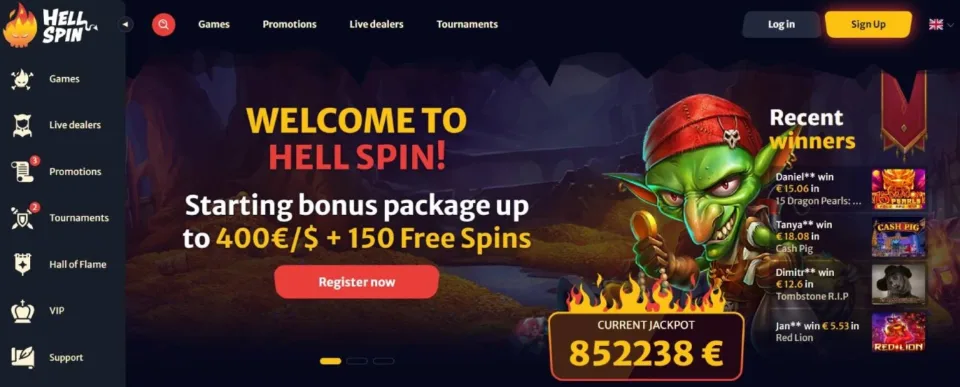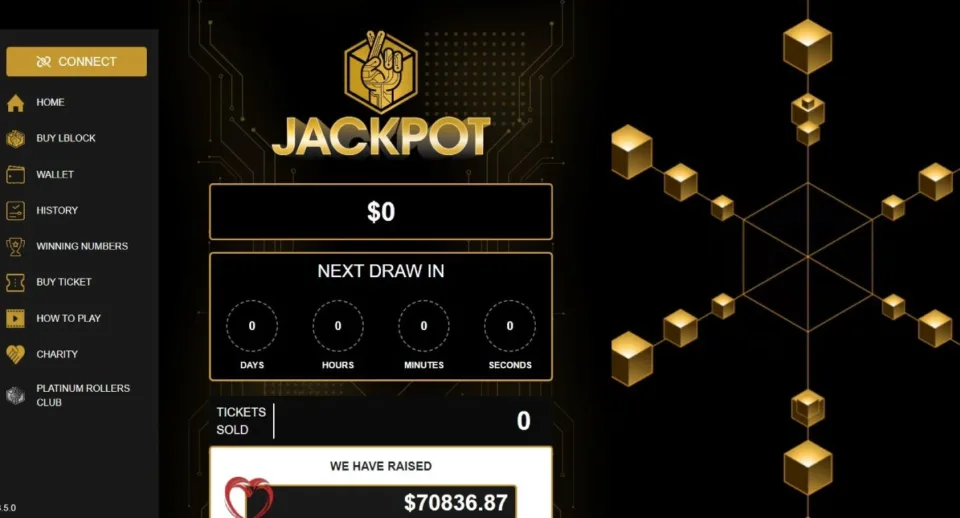4.9
- Personalised bonus offer
- Provably Fair Games
- Low House Edge
- Tournaments
- Fast transactions
- Hybrid casino
- Native tokens
- No wagering requirements
Ranked: Our Metaverse Gambling Site Picks
- BC.Game – Metaverse Casino – Supporting Over 120 Cryptos
- HellSpin Casino – Best for Rewarding Tournaments
- Lucky Block Casino – Best Metaverse Casino with $10,000 Welcome Bonus
Metaverse Casino Sites Reviewed
1. BC.Game – Metaverse Casino – Supporting Over 120 Cryptos

Founded in 2017, BC.Game has become a well-known and popular metaverse casino with a wide range of games. The games include casino games, sports betting, and games like the lottery. BC.Game’s unique selling points (USPs) include its huge gaming selection, which offers players access to casino games, sports betting, and lottery-style games. Also, there’s the interface, mobile compatibility, bonuses, responsive customer service, security, and so much more.
Fans of casino games can choose from a wide range of original games, including dice, roulette, slots, and live dealers. Also, BC.Game lets you bet on more than 30 different sports, including soccer, tennis, basketball, and even eSports.
Like most metaverse casinos, BC.Games offer an enticing welcome bonus. Unlike other casinos, however, BC.Game provides a bonus on the first four deposits made, not just the first. The first deposit will attract a bonus of 180%, and the bonus amount rises with each subsequent deposit, up to 240% for the fourth deposit.
However, it’s important to note that these deposit bonuses are paid in BCD, which is BC.Game’s native currency. BCD is worth the same as USD, and it can be used to bet on any of the casino’s games.
The government of Curacao has licensed and regulated this metaverse casino. This makes sure that its players are safe and secure. In addition, the casino provides 24/7 customer support via live chat and email. They also employ top-notch security measures to protect players’ personal and financial information.
| Crypto Bonus | Wagering Requirements | Minimum Deposit | Available Currencies |
|---|---|---|---|
| 1260% Up to 220,000 BCD | N/A | N/A | 120+ cryptos |
- Pros
- Wide selection of games, including casino games, sports betting, and lottery-style games.
- Attractive welcome bonus with bonus rewards on the first four deposits.
- 24/7 customer support is available via live chat and email.
- The platform offers several cryptocurrencies, including Bitcoin, Ethereum, Litecoin, and Dogecoin.
- Cons
- Lack of information on the security measures in place to protect user data.
- Some games have high minimum bets, which makes it hard for people who don't play often to join in.

2. HellSpin – Best for Rewarding Tournaments

HellSpin Casino is a cryptocurrency gambling platform that borrows an immersive, fiery, mysterious metaverse theme to add more life and excitement to gaming. Though a newcomer, having been established in 2022, the platform has a list of over 4,500 fun titles spread across all major gaming genres, like slots, table games, and live casinos. It’s home to some of the best tournaments, like Highway to Hell and Lady in Red, which offer players huge rewards. Owned and operated by the TechOptions Group B.V., the casino is safe and legitimate, with a Curacao license number GLH-OCCHKTW0702282021. Some of the top publishers on the site are NoLimit, Microgaming, Apollo, Pragmatic Play, NetEnt, Amatic, and Evolution Play, so you can be sure of fair and fun-filled gameplay. While you will not get many recurring promos, as a new player, Hell Spin will offer you a whopping 150% welcome bonus plus 150 free spins to play slots of your choice. You may also want to take advantage of the weekly reload bonus of 50% up to 100 free spins. Hell Spin’s popularity is partly due to its accessibility through mobile web browsers. Although there is no downloadable mobile app available, the website is optimized for a seamless experience on all mobile browsers.
| Crypto Bonus | Wagering Requirements | Minimum Deposit | Available Currencies |
|---|---|---|---|
| 150% up to $900 | 40x | 0.0001 BTC (or equivalent) | BTC, ETH, LTC, XRP, USDT |
- Pros
- Legitimate platform
- Low minimum deposit
- Top game providers
- User friendly
- Cons
- New casino

3. Lucky Block Casino – Best Metaverse Casino with $10,000 Welcome Bonus

Lucky Block is a 2022-established metaverse casino and sportsbook with an inclination toward crypto payments. It supports at least ten digital coins, including popular ones like BTC and LTC, stablecoins like USDT and BNB, and the platform’s native coin, the LBLOCK. Users are spoilt for choice with over 2,500 games to pick from, ranging from slots to table games, crash titles, and live casino.
The best part is that top industry software developers like Hacksaw Gaming, Relax Gaming, Nolimit City, Endorphina, Push Gaming, NetEnt, Red Tiger Gaming, Big Time Gaming, and Spinomenal provide all titles. Sports lovers enjoy a selection of over 35 sports spread out across hundreds of markets. One notable attraction on this site is the bonus and promo section. First, the metaverse casino welcomes new players with a whopping 200% bonus match on the first deposit to a maximum of $10,000. You also get 50 free spins to play Wanted Dead or Alive.
Once a regular member, Lucky Block will keep rewarding you with lots of perks to make sure you never run out funds. Take advantage of the game of the week free spins, the Monday reload bonus, and more. Security-wise, Lucky Block is reliable, with a Curacao gaming license number #5536/JAZ. It also employs industry standard SSL encryption, which reduces the threat of compromised user credentials.
| Crypto Bonus | Wagering Requirements | Minimum Deposit | Available Currencies |
|---|---|---|---|
| 200% deposit match up to $10,000 | 35x | 0.0001 BTC (or equivalent) | BTC, ETH, BCH, XRP, DOGE, LTC, USDT TRX, ADA |
- Pros
- Up to $10,000 welcome perk
- Supports multiple cryptos
- Instant payment processing
- Safe and reliable
- Cons
- Inexperienced operator

What is a Metaverse Casino?
Metaverse casinos are gambling platforms that are created to operate and provide gambling opportunities to gamblers in a metaverse. Like gambling dApps, metaverse casinos are built and run using blockchain technology. As a result, cryptocurrencies are the principal way to make and receive payments on these gambling platforms.
The game selection on most metaverse casinos is quite similar to casino games offered on traditional gambling platforms. As a result, gamblers will find casino games like Blackjack, Roulette, Backgammon, Poker, and Slots on our recommended metaverse casinos.
Metaverse casinos and virtual reality gambling using cryptocurrencies are still very new and most of them are currently in construction. As a result, there is only a limited number of metaverse casinos available in the gambling world, most of them currently in Decentraland.
How Does it Work?
More and more crypto gambling sites are incorporating metaverse elements into their online casinos. They provide players with the opportunity to experience live gaming without leaving their homes.
But how exactly do these casinos function? Below is an overview of how players can start playing at a metaverse casino:
Choose a Crypto Wallet
Metaverse casinos are created and run using blockchain technology. This means that digital tokens are the primary form of currency used on these gaming sites. Players need a secure crypto wallet that works well with their chosen metaverse so they can make transactions.
Connect Your Wallet to the Metaverse
Metaverse casinos don’t require users to sign up or give KYC information, which makes them a good choice for people who want to gamble without a lot of hassle. To begin playing, users can simply visit their preferred metaverse platform and connect their wallets to gain access to the metaverse.
Design the Avatar
To get started, players are required to choose their avatar. Most platforms let players choose from a wide range of features, such as facial features, accessories, and outfits. It is also necessary to assign a name to the avatar.
Visit the Metaverse Casino
Once the player has chosen his or her avatar, he or she can either type in the coordinates of the metaverse casino’s address to go straight there, or they can walk there. They can also take some time to explore other parts of the metaverse before heading to the casino. For example, Decentraland has many other places to have fun, such as parks, movie theatres, and recreational facilities.
Start Playing
To start playing, players only need to choose their preferred game from the casino options. The casino will then tell you step-by-step how to move forward with betting. However, many metaverse casinos also integrate NFTs into their platforms. They allow players to purchase blockchain-based NFTs that protect in-game items like virtual land and avatars.
Types of Bonuses Available
Free Spins
In Metaverse online casinos, free spins are frequently given as bonuses for slot games. They can be used without the need for cryptocurrency. Free credit slots allow players to enjoy themselves without any risk.
Free Bets
Metaverse casinos that offer sports betting often provide free bets to their players. These free bets allow gamblers to try their luck once again without risking their own cryptocurrency. Additionally, some Metaverse casino games may also offer free chips as a reward.
Deposit Bonuses
The most prevalent type of bonus in metaverse casinos is the deposit bonus. They are usually given to players when they fund their casino accounts using cryptocurrencies.
While many casinos offer matching deposit incentives only to new customers, some also offer them to existing account holders. Some Metaverse casinos offer “no deposit bonuses” to new players. Players can use a free bonus credited to their account to try out casino games without risking their own money.
Metaverse casinos may offer no deposit bonuses to new players. This means that they will receive a bonus amount in their account without having to make a deposit. This bonus can be used to try out various games within the metaverse casino.
How to Select the Best Metaverse Casino?
Coming across the best metaverse casinos is not an easy task. However, the process of searching for the best metaverse casinos can be a fun prospect.
In the search for these casinos, it’s not the usual visits to websites and devouring of terms and conditions. However, you can venture out into the metaverse to get a firsthand experience. To help you pick the best metaverse casino, you should pay close attention to the following factors:
Security Measures
When selecting a metaverse casino, it’s important to consider security measures. Most metaverse casinos accept cryptocurrency, so customers don’t have to give out a lot of personal information when they sign up. All that’s needed to make a deposit is a compatible crypto wallet and digital funds.
Some metaverse casinos might also have a valid gaming licence, which is usually given out in Curacao because of tax rules. A licence can offer players some peace of mind by providing a level of transparency and legitimacy, though these are not guaranteed.
Variety of Games
Before choosing a metaverse casino game, it’s important for players to see what games are available on the platform. Games like roulette, blackjack, dice, and poker are typical fare at casinos across the Metaverse. Some game categories may not have as many options on metaverse casinos as they do on regular cryptocurrency gaming sites.
Accepted Cryptos
Since all metaverse casinos are based on cryptocurrency, choosing one that accepts a certain range of virtual currencies is important. Even though most casinos only accept popular cryptocurrencies like BTC and ETH, many now also accept stablecoins like USDT and DAI.
Some casinos accept these well-known digital currencies, while others have started their own crypto tokens. If a casino uses this method, players must change their deposits into the casino’s own currency before they can bet.
Payments and Withdrawals Speed
Metaverse Casino is great since it offers instant processing of deposits and withdrawals. Traditional casinos that use cash are easy to deposit money into, but withdrawals can take up to five business days, which is inconvenient for players.
It’s incredible and builds trust when payments are made directly to a digital wallet. Compared to traditional casinos that use fiat currency, the ability of crypto casinos to quickly transfer winnings to a player’s wallet makes them more attractive. This is due to the convenience and speed of cryptocurrency transactions. When you make a withdrawal from a Metaverse casino, you usually have to pay a network fee, which can change depending on how busy the blockchain network is.
NFT Offerings
Metaverse casinos provide a broad variety of NFTs, or digital assets (non-fungible tokens). NFTs might be derived from avatars to represent accessories, clothing, and other aspects. At certain establishments, gamers may even use NFTs to win slot machines or even real estate.
With the ability to acquire NFTs and then resell them to collectors, players at metaverse gambling sites may make a decent living. Before making a final decision, it’s a good idea to learn about the different NFTs a metaverse casino has to offer and the long-term returns they might bring.
Events, Tournaments, and Promotions
Players would rather play at a casino that tries to keep its customers coming back. That is, a reputable metaverse casino that has its players at heart would provide sign-up bonuses. Some metaverse casinos provide deposit bonuses, chip giveaways, free bets, free spins, and other incentives to their players.
Customer Support
A metaverse casino that provides 24/7 customer support through live chat and email. But if a metaverse casino doesn’t have live chat support, it should have a FAQ (Frequently Asked Questions) section with a lot of information. The help desk is considered to be the best option. These features allow players to easily receive assistance whenever they require it. But if a metaverse casino doesn’t have live chat support, it should have a FAQ (Frequently Asked Questions) section with a lot of information.
Some metaverse casinos may offer a social media account specifically for players to get fast answers to their inquiries.
Decentralization

Metaverse casinos are launched and operated on blockchain technology, so central authorities cannot control the activities on these platforms. As a result, users will enjoy features like smart contracts and a wide range of digital assets. Due to all of these features, metaverse casinos provide more transparency and security to players than traditional gambling platforms.
Excellent Rewards
![]()
Several metaverse casinos offer cool rewards to players who use their services. Some gambling platforms even integrate play-to-earn features into their games. As a result of this feature, players will be able to earn money while playing on the platform. Additionally, with this feature, players can win back money after losing during gameplay.
Payment Options

Metaverse casinos only accept and offer cryptocurrencies as their primary payment option. Therefore, casino players should enjoy fast deposits and withdrawals when they gamble on any of our listed metaverse casinos. Additionally, the transaction fees attached to transactions on all of our listed gambling platforms are low.
Earn House Profits

Metaverse casinos generally distribute a good chunk of their house profits to their token or NFT holders. Moreover, many of these casinos have integrated Play-to-Earn economics and therefore make it possible to not only generate a small passive income but actually make a living.
Anonymity

Since you will use a web3 wallet to register your Metaverse account, you have the possibility to stay completely anonymous while gambling at these Metaverse casinos as they generally do not require a KYC check.
Gaming Experience

If you haven`t tried it yet – what are you waiting for?
Metaverse casinos are the future of gambling. They deliver an exceptional gaming experience unmatched by any other online casino. Only going to Vegas in real life can combat this.

How to Play in a Metaverse Casino?
The process for playing casino games in a metaverse casino is very simple and uncomplicated. However, new players are expected to register and create a new account on their desired metaverse casino. This will also include creating your first digital twin, that will roam the metaverse casino of your choice.
Furthermore, users need to have their crypto wallets and link them to their personal accounts at the casino. Many of our listed metaverse casinos accept crypto wallets like Meta Mask, Fortmatic, and Wallet Connect.
- If you wish to play in a metaverse casino, select and create any of these wallets. Decentral.Games is currently only compatible with Metamask.
- Choose one of the listed metaverse casinos on our list.
- Connect your wallet.
- Fund your wallet with the native metaverse token. In Decentral.Games this would be DG.
- After successfully connecting your wallet to play in a Metaverse casino and creating an avatar, you can enter the Metaverse casino.
- Find your table and start betting with your funds in your web3 wallet.
What is the difference between Virtual Reality (VR), Augmented Reality (AR), and Mixed Reality (MR)

Virtual Reality (VR) is a technology that simulates a real-world environment by immersing users in a completely digital environment. VR headsets allow users to immerse themselves, interact in a 3D environment, and even move around. Currently, players can only interact with a new world using add-ons which gives the digital world a level of realism that has yet to be rendered. Virtual reality can mimic the real world but requires developers to code and create a new world.

Augmented Reality (AR)
Augmented Reality (AR) technology supplements the physical world with virtual objects and information. AR technology overlays contextual information on the user’s field of vision and can be accessed using digital technologies like smartphones. For example, social media filters are an example of AR since it doesn’t transport the user to another environment but enhance the real world through elements like graphics, sound, and GPS data. In the gambling industry, AR technology has the potential to enhance the player experience by combining the old and the new to develop new ways of interacting with the casino.
Mixed Reality (MR)
Mixed Reality (MR) technology blends the elements of both VR and AR, providing users with an interactive and immersive realistic environment. MR technology enhances how users interact with their surroundings, creating an environment where digital and physical objects can coexist. MR technology is currently in its infancy, but it has the potential to revolutionize how we experience media, social interaction, and gaming.
Extended Reality (XR)
Extended Reality (XR) is an umbrella term that includes all immersive technologies. It promotes a tangible approach to these technologies, creating a seamless digital experience through new developments. XR is achievable through various experiences and new technologies overlaid in our physical interaction. XR technology has the potential to redefine how we engage with our surroundings, creating a blended experience that allows us to interact with both digital and physical elements in a more fluid and intuitive manner.
The Future of Metaverse Gambling and Betting
The global online gambling market is estimated to exceed $127 billion by 2027. This indicates a high demand for innovative gambling experiences. Virtual technologies like the metaverse and virtual reality are expected to contribute to this growth. The global virtual reality market is projected to reach $57.55 billion by 2027, while the augmented reality market is estimated to exceed $140 billion by 2024. This trend provides a strong foundation for the expansion of metaverse gambling.
As the metaverse evolves, players will be able to explore casinos, sportsbooks, and betting arenas in the virtual metaverse spaces. These virtual arenas will be designed with stunning graphics, realistic simulations, and interactive features, creating an unparalleled level of immersion and engagement. The integration of blockchain technology will be a key aspect that shapes the future of metaverse gambling. Blockchain’s decentralized nature provides transparency, security, and fairness, which are crucial elements for the gambling industry.
Smart contracts can ensure fair gaming and enable instant and secure transactions using cryptocurrencies. This integration will empower players with true ownership of their digital assets, such as in-game items, virtual currencies, and collectibles, adding a new layer of value and monetization opportunities. In addition, the metaverse will facilitate social interactions and community engagement within the gambling ecosystem. Players will have the ability to interact with each other, form communities, and participate in multiplayer games or tournaments. This social aspect will enhance the overall gambling experience, fostering collaboration, competition, and shared excitement.
Final Thoughts
Metaverse casinos have the potential to revolutionize the gambling industry by providing realistic environments, customizable avatars, and gamified experiences. They enable social interaction, community engagement, and the seamless integration of virtual economies. With the ongoing advancements in technology and the rising demand for immersive gaming experiences, metaverse casinos are set to become a major player in the gambling landscape.
There is already evidence of a growing market size for online gambling, the increasing adoption of virtual reality and augmented reality technologies, the integration of blockchain for enhanced security and transparency, and the success of existing virtual casinos. Players can look forward to a future where they can enjoy a truly interactive and personalized gambling experience, with access to a wide range of games, tournaments, and social interactions. However, it is important for regulators to establish clear frameworks to ensure user protection and responsible gambling practices in this evolving landscape.
How to find the best metaverse casino?
When choosing the best metaverse casino, you should think about its reputation, game selection, security, compatibility, bonuses and rewards, and customer service. By taking these into account, you can choose a metaverse casino that fits your gaming preferences and needs.
How secure and reliable are metaverse casinos?
Metaverse casinos utilize blockchain technology and cryptocurrencies, making them more secure and reliable than conventional online casinos. However, like any other online platform, they can be vulnerable to hacking and scams. Players should choose safe and reputable metaverse casinos and do what they need to do to keep their money and personal information safe.
Do I need special hardware or software to play in a metaverse casino?
To play in a metaverse casino, all you need is a device with internet access and a cryptocurrency wallet that works with the casino. You also need the ability to run a metaverse platform; no special hardware or software is necessary.
Are there age restrictions for playing in a metaverse casino?
To play in a metaverse casino, players need to be of legal gambling age, typically 18 or 21 years old, depending on the jurisdiction. Before playing any games in a metaverse casino, you need to find out if there are any age limits.
How do I cash out my winnings from a metaverse casino?
To cash out your winnings from a metaverse casino, go to the “Withdraw” section and choose the method you want to use. Enter the amount you wish to withdraw and wait for the transaction to be processed. Be aware of potential fees and check the casino’s specific rules and procedures for cashing out.
What are the potential risks and drawbacks of participating in a metaverse casino?
One of the possible risks and downsides of playing in a metaverse casino is that you could lose money. Like any form of gambling, the potential for scams or fraud is possible. Also, the fact that cryptocurrency transactions are anonymous and the lack of rules in some places can make fraud or theft more likely.

Facts Checked by Josip Putarek, Senior Author









 julien@contentbydesign.ca
julien@contentbydesign.ca 